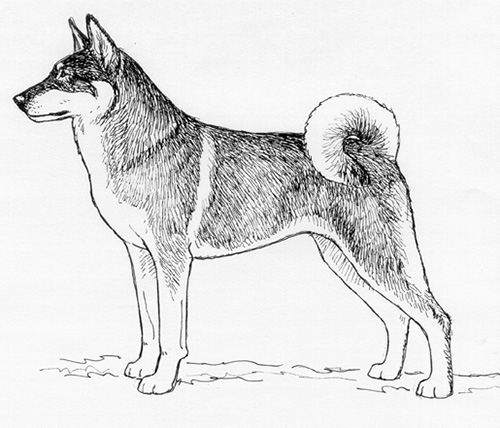Shikoku
Northern Breed Group
The goals and purposes of this breed standard include: to furnish guidelines for breeders who wish to maintain the quality of their breed and to improve it; to advance this breed to a state of similarity throughout the world; and to act as a guide for judges.
Breeders and judges have the responsibility to avoid any conditions or exaggerations that are detrimental to the health, welfare, essence and soundness of this breed, and must take the responsibility to see that these are not perpetuated.
Any departure from the following should be considered a fault, and the seriousness with which the fault should be regarded should be in exact proportion to its degree and its effect upon the health and welfare of the dog and on the dog’s ability to perform its traditional work.
History
The Shikoku is descended from the medium sized dogs of ancient Japan. It was developed as a hunting dog, mainly used on boar in the mountainous regions of Kochi. There were originally three varieties of this breed, each named for the area in which it was bred.
The Shikoku was recognized by the United Kennel Club in 2006.
General Appearance
The Shikoku is a medium sized dog, well balanced and with well developed, clean cut muscles. It has prick ears, a curled or sickle tail, and a sesame colored coat. It is a strong, well-boned and compact breed.
Disqualifications: Unilateral or bilateral cryptorchid.
Characteristics
An enthusiastic hunter with marked endurance, the Shikoku is energetic and alert, yet docile with his master.
Disqualifications: Viciousness or extreme shyness.
Head
SKULL
Broad in forehead. The stop is shallow but defined.
MUZZLE
Rather long and wedge shaped, with a straight nasal bone.
TEETH
The Shikoku has a complete set of evenly spaced, white teeth meeting in a scissors bite.
Faults: Slightly overshot or undershot bite.
Disqualifications: Extremely overshot or undershot bite.
NOSE
Black.
EYES
Relatively small, triangular in shape, set well apart and dark brown in color.
EARS
Small, triangular, strongly pricked and slightly inclined forward.
Disqualification: Ears not pricked.
Neck
Thick and powerful.
Forequarters
The shoulders are moderately sloping with strong muscles.
FORELEGS
The legs are straight and clean cut. The elbows set close to the body, and the pasterns are slightly sloping.
Body
In proportion, the body is just slightly longer than tall in a ratio of 11:10. The chest is deep, and the ribs are well sprung. The withers are high, and the back is straight and strong. The loin is broad and muscular, and the belly is well tucked up.
Hindquarters
The hindquarters are powerful, with well developed muscles.
HIND LEGS
The hocks are moderately angulated and very tough.
Feet
Tightly closed, with well arched toes and hard, elastic pads. The nails are hard and dark in color.
Tail
Thick, set on high and carried curled over the back or like a sickle. The tip nearly reaches the hock when let down.
Disqualifications: Hanging or short tail.
Coat
Double, with a harsh, straight outer coat and a soft, dense undercoat. The hair on the tail is rather long.
Fault: Coat too long.
Color
Sesame (equal mix of black and white hairs), black sesame (more black than white hairs), and red sesame (ground color of red mixed with black hairs).
Disqualification: Albinism
Height
Height at the withers for males is 20.5 inches. For females, it is 18 inches. There is a tolerance of one inch in either direction.
Gait
Light and quick, with rather narrow strides.
Disqualifications
(A dog with a Disqualification must not be considered for placement in a conformation event, and must be reported to UKC.)
Unilateral or bilateral cryptorchid.
Viciousness or extreme shyness.
Albinism.
Extremely overshot or undershot bite.
Ears not pricked.
Tail hanging or too short.

Looking for a Dog?
Find a dog that will fit your family.
Note: The breeders on this list are not endorsed by UKC.
©Copyright 2006, United Kennel Club
